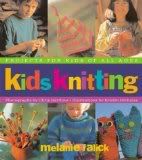Knitting is often viewed as an activity for elderly ladies. Many young adults express an interest in it as well, knitting fashionable sweaters and funky scarves for themselves and their friends and families. Did you know that knitting is a wonderful activity for kids, too?
Children tend to become bored easily, and knitting is a very effective remedy. During car trips or while waiting for dinner, kids can occupy themselves by knitting. It helps them develop longer attention spans and improves their fine motor skills, and most kids find it enjoyable and relaxing.
There are many simple knitting projects that kids can do. Here are ten ideas:
1) Bookmarks – You can quickly and easily create a yarn bookmark by finger knitting. This is a great first project, as it requires no needles and no fancy stitches. All kids have to do is make a row of stitches.
2) Scarves – Simple scarves are among the easiest knitting projects. Using one color and the basic stitch, this provides excellent practice for young knitters. And the finished product makes a useful accessory for your child, or could be given as a gift to a grandparent or other family member to cherish for years to come.
3) Belts – Knitting a belt is very similar to knitting a scarf. The main difference is that it’s not as wide. Just knit a rectangle long enough to go around the waist and tie, and you’re done.
4) Squares – Knitted squares can be used in a variety of projects. If you need some for something you’re working on, let your child make them. This is a great way to practice making nice, even stitches that aren’t too tight.
5) Bean bags – A basic bean bag is easy to make out of two knitted squares. And if your child is interested in sewing, it provides an opportunity to practise that as well. Just have your child knit two squares of the same size, sew them together on three sides, put some beans in an old stocking and insert it in the bag. Sew the fourth side up, and it’s all done!
6) Coasters – Knitted squares can be used as coasters. Your child can knit up a set to use at home or give as a gift. If she would like to try a different shape, patterns can be found online and in beginners’ knitting books.
7) Dishcloths – Knitted dishcloths are great for getting those stubborn plates clean. And they make wonderful projects for young knitters. The broken rib pattern is a good choice for this project, and it’s an easy new stitch pattern to introduce to kids.
8) Envelope purses – An envelope purse is very easy for kids to make. Just knit a large rectangle, fold it together leaving a flap at the top, and sew the sides together. Add a knitted strap, and you have a stylish new bag.
9) Baby bibs – If there’s a baby in the family, big sisters, brothers or cousins will jump at the chance to make something for him. Knitting a baby bib can be as easy as stitching a large square and a cord, then sewing the cord on.
10) Animals – Knitting stuffed animals is a good way to introduce shapes to kids. They can knit two simple animal shapes, sew them on all sides but one, stuff and finish for a cute new toy.





